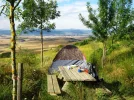Some of us, myself included, have consistently stated that Pilgrim numbers during this "Year of Mercy" were going to behave much the same way as a formal Holy Year, at least insofar as observant Catholics are concerned. The spiritual benefits are largely identical.
Then there is the increasing "uptake" by commercial travel agencies and organized groups soaking up reservable bed space formerly occupied by solo pilgrims, like me. This pushes single, walking pilgrim more into albergues, than before. The net result is increase daily pressure at places of lodging at virtually everyplace along the Camino, whether at a formal
Brierley stage or not. I am concerned that our anecdotal observations are all coming to be facts, and sooner than originally predicted.
Finally, there is just the human phenomenon of more people doing the Camino, relating their wonderment and positive experiences, and inducing more people to do it, whether as solo pilgrims or in an organized tour group. I admit to being very guilty of spreading the good word. But is that wrong?
THAT is the paradox. We are bound to harm the overall Camino over time by our admiration and kind words towards it as an institution. It is like putting too much plant food on a growing plant. We end up killing it with kindness.
All in all, and taken together, what we are seeing is a "snowball" effect of increasing popularity, of at least the
Camino Frances, compounded by the effect of the papal-proclaimed Year of Mercy (cum Holy Year). I predict this will continue into the future. I submit it will reach critical mass before the next formal Holy Year in 2021.
By then, the provincial and regional juntas and localities along the
Camino Frances had better have a plan sorted for dealing with this increasing wave. The alternative will be large numbers of disgruntled pilgrims, with many saying and writing negative things about their experiences. THIS, in return will have an out-year downward effect on the Camino pilgrim numbers. But the long term damage to Northwest Spain's tourism industry, what there is of it, will have been done. Once this happens, turning it around will NOT be easy.
Learning from prior mistakes, juntas building modern albergues by failing to equip kitchen so they can actually be used is NOT an answer. If you are going to do something, do it right. If you do not want people cooking in junta albergues, so they are compelled to patronize local eateries, do not build-in a kitchen in the first place. Apply the funds towards adding square footage with more beds and more bathroom facilities, or coin-operated laundry facilities.
Within 10 years, if enough quality bed space is NOT added to the
Camino Frances, one of two things will happen:
1. People will stay away from this historically popular and central route, this hurts all the villages and towns along The Way; or
2. An enterprising entrepreneur WILL build a network of private albergues to a simple, efficient standard that puts all the extant albergues to shame for standards and value for money. They would be located in small hamlets or villages, now not at any standard daily stage end-point.
I am thinking micro-sized versions of the Dutch-operated Roncesvalles albergue, housing perhaps 30 - 40 pilgrims in single or double private alcoves., with Euro operated rucksack lockers and electrical outlets at every bed space. Place them along the sendas, on leased farm land, in villages or hamlets between the
Brierley stages, make them all reservable online (just build an app for that) and provide clean, safe, convenient and customer-friendly overnight accommodations, and watch the profits flow.
Any Spanish farmer who would pass up a predictable, annual rental payment for a hectare or two of their under-utilized or fallow land would be a fool. It is easy and free money for most of them, at least those who are land poor in a faltering economy. Also, I am willing to bet that millennials would prefer staying in a very standard, clean, compact, predictable, affordable, private McAlbergue, to what is currently found on a hit and miss basis now. Whether you agree or not, these 20 somethings ARE the future of the Camino. Build what they expect, and they will come...
If I could obtain the venture capital, I would already be on the ground developing this accommodation model. The business model is easy. The political model for obtaining local permission and acceptance is a little more difficult, but not insurmountable with the correct approach. I have developed that approach, but as is the case with most good business ideas, it exists solely in my head for now. I am many things, but stupid ain't one of them. If anyone out there wants my ideas, write me a private communication and we can discuss terms.
There you go. What was predicted, IS HAPPENING. I am surprised that it is happening sooner than I (and others) thought it would. However, it is developing along the lines I (we) thought it would. First the private, reservable lodging is oversubscribed, then albergues at the
Brierley stages are oversubscribed, and lastly even the off-stage albergues and hostals are being fully occupied. AND IT IS ONLY MID-MAY!
Watch what happens once the universities empty for the summer break. At the very least, I hope the local juntas start to lighten up on ad hoc camping along the route. Because that is the only accommodation many late-arriving people will find this coming summer.
For me, personally, if my doctors determine that I am able to continue walking the Camino, I will plan to do my future Caminos on alternative Camino routes, plan my Camino for off-months (the autumn is starting to appeal to me), and seek more clever ways to adapt and overcome this developing problem.



























